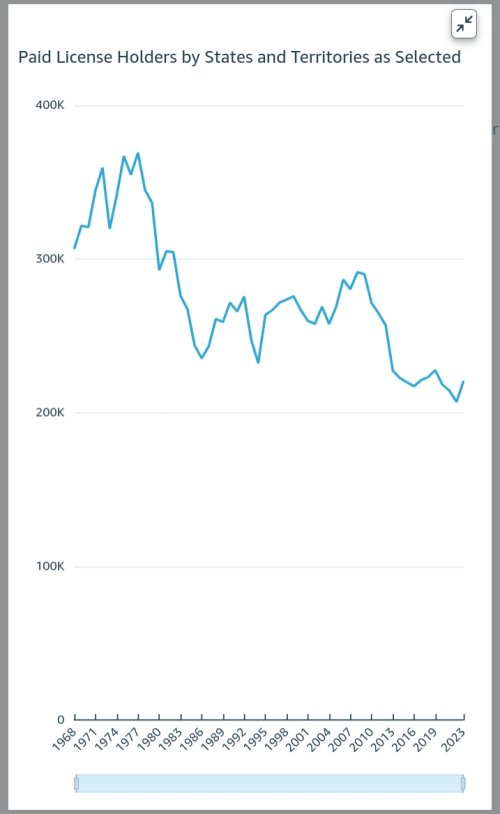Pucky Freak
Well-known member
Following hunting influencers on social media platforms does not require a fee. Neither does watching influencer content on Youtube. However, both actions cost us access to quality hunting, and drive up costs of licenses, tags, and points.

Hunter recruitment will soon be the bane of hunters' existence, if it is not already. Huntable acres in America accessible to anyone but the wealthy are in continuous decline due to habitat loss and degradation, human population migration to rural areas, residential development (ranchettes and subdivisions), decline of legacy ranching and farming, hunting leases, outfitter welfare, erosion of the NA model of wildlife conservation, and the monetization of game animals.
Meanwhile, boosting total hunter hours afield per year is a goal of all entities in the illustration above. Ostensibly, the purposes of this goal is to fund wildlife conservation efforts, and maintain a cadre of politically-active ambassadors for wildlife conservation. While it is arguable that hunter recruitment is advancing these purposes, increased total hunter hours afield per year is producing other consequences for hunters, habitat, and wildlife. As huntable acres decline and total hunter hours afield per year increase, human recreation hours are concentrated in smaller areas, resulting in wildlife population decreases, and degraded wildlife habitat. Furthermore, hunter satisfaction declines due to crowding, increased distance to travel to hunt, and increased cost to hunt out of state.
Personally, I prefer to have robust wildlife populations, quality wildlife habitat, less crowding, less distance required to travel to hunt, and affordable NR hunting opportunities. Here are some possible actions a hunter can take to curb recruitment:
-Unfollow hunting influencers on social media platforms. Hunting gear manufacturers fund influencers based on the number of followers they have, and the more hunting influencers get gear/funding, the more animals they need to kill to keep the money flowing.
-Limit or eliminate watching media content published by hunting influencers
-Stop giving money to hunting nonprofits that fund recruitment. Most hunting nonprofits engage in worthy conservation work, so an alternative is voicing a desire within the organization to end recruitment.
-Buy less hunting gear. Money spent on hunting gear funnels back to recruitment so the companies can make more sales.
-Put the pressure on G&F agencies to cease funding hunting influencers to promote hunting opportunities. Also refrain from purchasing tags, stamps, licenses, and permits that won't be used.
Of course it is also helpful for hunters to engage directly in habitat work and creating/maintaining affordable places to hunt. Another significant factor in the human saturation in wildlife habitat equation is the enormous impact of so-called "non-consumptive" outdoor recreationalists. It's likely worthwhile to be involved in social and political measures to regulate all types of recreational use to allow more space for wild places to retain a greater degree of wildness.

Hunter recruitment will soon be the bane of hunters' existence, if it is not already. Huntable acres in America accessible to anyone but the wealthy are in continuous decline due to habitat loss and degradation, human population migration to rural areas, residential development (ranchettes and subdivisions), decline of legacy ranching and farming, hunting leases, outfitter welfare, erosion of the NA model of wildlife conservation, and the monetization of game animals.
Meanwhile, boosting total hunter hours afield per year is a goal of all entities in the illustration above. Ostensibly, the purposes of this goal is to fund wildlife conservation efforts, and maintain a cadre of politically-active ambassadors for wildlife conservation. While it is arguable that hunter recruitment is advancing these purposes, increased total hunter hours afield per year is producing other consequences for hunters, habitat, and wildlife. As huntable acres decline and total hunter hours afield per year increase, human recreation hours are concentrated in smaller areas, resulting in wildlife population decreases, and degraded wildlife habitat. Furthermore, hunter satisfaction declines due to crowding, increased distance to travel to hunt, and increased cost to hunt out of state.
Personally, I prefer to have robust wildlife populations, quality wildlife habitat, less crowding, less distance required to travel to hunt, and affordable NR hunting opportunities. Here are some possible actions a hunter can take to curb recruitment:
-Unfollow hunting influencers on social media platforms. Hunting gear manufacturers fund influencers based on the number of followers they have, and the more hunting influencers get gear/funding, the more animals they need to kill to keep the money flowing.
-Limit or eliminate watching media content published by hunting influencers
-Stop giving money to hunting nonprofits that fund recruitment. Most hunting nonprofits engage in worthy conservation work, so an alternative is voicing a desire within the organization to end recruitment.
-Buy less hunting gear. Money spent on hunting gear funnels back to recruitment so the companies can make more sales.
-Put the pressure on G&F agencies to cease funding hunting influencers to promote hunting opportunities. Also refrain from purchasing tags, stamps, licenses, and permits that won't be used.
Of course it is also helpful for hunters to engage directly in habitat work and creating/maintaining affordable places to hunt. Another significant factor in the human saturation in wildlife habitat equation is the enormous impact of so-called "non-consumptive" outdoor recreationalists. It's likely worthwhile to be involved in social and political measures to regulate all types of recreational use to allow more space for wild places to retain a greater degree of wildness.









